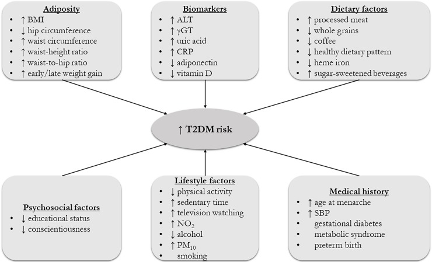what are some of the causative factors that get someone down the road to diabetes? Read part 2 of our ODX Insulin Resistance Series to find out.
Insulin Resistance and the Road to Diabetes
Dicken Weatherby, N.D. and Beth Ellen DiLuglio, MS, RDN, LDN
The ODX Insulin Resistance Series
- Insulin Resistance part 1 - The Biochemistry and Physiology of Insulin
- Insulin Resistance part 2 - Insulin Resistance and the Road to Diabetes
- Insulin Resistance part 3 - Assessing Insulin Resistance - Signs, Symptoms & Individual Biomarkers
- Insulin Resistance part 4 - Take a U-Turn and Reverse Insulin Resistance
- Optimal - The Podcast: Episode 3 Insulin Resistance
The road to insulin resistance and diabetes is paved with added sugar, processed food, micronutrient insufficiencies, and a sedentary lifestyle.
This same path may also lead to other complications including metabolic syndrome, polycystic ovary syndrome (PCOS), non-alcoholic steatohepatitis (NASH), and non-alcoholic liver disease (NAFLD).
Even in those with normal glucose tolerance, the presence of insulin resistance (and its major risk factors of hyperinsulinemia, increased body fat, obesity, and sedentary lifestyle) is predictive of type 2 diabetes development. [1]
In the United States, according to the 2020 CDC National Diabetes Statistics Report: [2]
- An estimated 34.1 million adults (13% of adults) have diabetes…7.3 million of them are unaware and undiagnosed.
- Another 88 million adults (34.5%) have prediabetes.
- Ultimately, almost half of US adults have blood sugar regulation issues, and that is not counting pre-prediabetes!
Basic risk factors for type 2 diabetes (T2DM)
- Prediabetes
- Overweight
- 45 years old or older
- Parent, brother, or sister with T2DM
- Sedentary lifestyle (physically active fewer than 3 days/week)
- Gestational diabetes
- Non-alcoholic fatty liver disease
- Ethnicity: African Americans, Hispanic, Native American, Native Alaskan
- And of course, poor diet
A 2018 meta-analysis of 86 papers confirmed robust evidence for a variety of dietary, lifestyle, medical, biochemical, environmental, and psychosocial factors that increase risk of type 2 diabetes. [3]
- Adiposity, high BMI, metabolically unhealthy obesity, high waist circumference, high waist-to-height ratio, high waist-to-hip ratio, low hip circumference
- Decreased physical activity, high sedentary time and duration of television watching
- Low level of education and conscientiousness
- Smoking, air pollution
- Medical conditions
- High systolic blood pressure, metabolic syndrome
- Late menarche age, gestational diabetes, preterm birth
- Major depressive disorder, bipolar disorder
- Nitrogen dioxide exposure
- Psoriasis
- Serum biomarkers
- Increased alanine aminotransferase, gamma-glutamyl transferase, uric acid, ferritin, and C-reactive protein
- Decreased level of adiponectin and vitamin D
- Unhealthy dietary pattern
- Increased consumption of processed and red meat, sugar-sweetened beverages
- Decreased intake of whole grains, coffee
- Moderate intake of alcohol
It is not surprising that chronic inflammation may trigger insulin resistance, as evidenced by its association with inflammatory biomarkers. [4]
Schematic representation of risk factors for T2DM with convincing or highly suggestive evidence.

"The symbol ↑ denotes a higher exposure to a risk factor, and the symbol ↓ represents a lower exposure to a risk factor. For alcohol consumption, never drinkers presented a higher risk for T2DM than moderate drinkers."
Source: Bellou, Vanesa et al. “Risk factors for type 2 diabetes mellitus: An exposure-wide umbrella review of meta-analyses.” PloS one vol. 13,3 e0194127. 20 Mar. 2018.
Patients traveling down this road may think that the milepost for prediabetes is inconsequential. However, complications of prediabetes include heart disease and stroke and these complications extend in diabetes to kidney failure, blindness, and lower extremity amputation. [5]
Health is priceless and no degree or stage of disease is inconsequential. Making even small changes in diet, nutrition, and physical activity will be well worth the investment.
Up Next - Insulin Resistance part 3 - Assessing Insulin Resistance - Signs, Symptoms & Individual Biomarkers
References
[1] Gutch, Manish et al. “Assessment of insulin sensitivity/resistance.” Indian journal of endocrinology and metabolism vol. 19,1 (2015): 160-4.
[2] National Diabetes Statistics Report 2020.
[3] Bellou, Vanesa et al. “Risk factors for type 2 diabetes mellitus: An exposure-wide umbrella review of meta-analyses.” PloS one vol. 13,3 e0194127. 20 Mar. 2018.
[4] Khan, Haseeb A et al. “Biomarker potential of C-peptide for screening of insulin resistance in diabetic and non-diabetic individuals.” Saudi journal of biological sciences vol. 25,8 (2018): 1729-1732.
[5] National Center for Chronic Disease Prevention and Health Promotion: Diabetes. [CDC Website].






